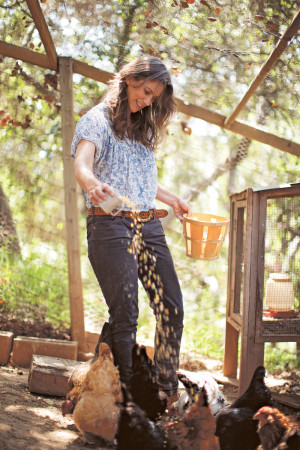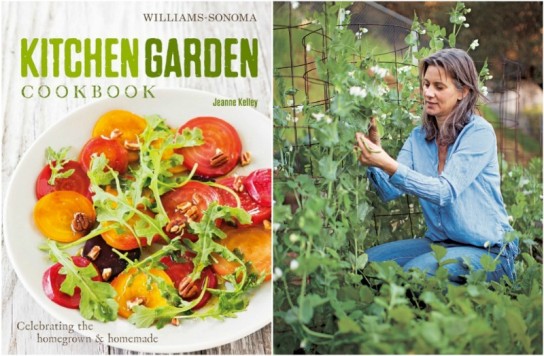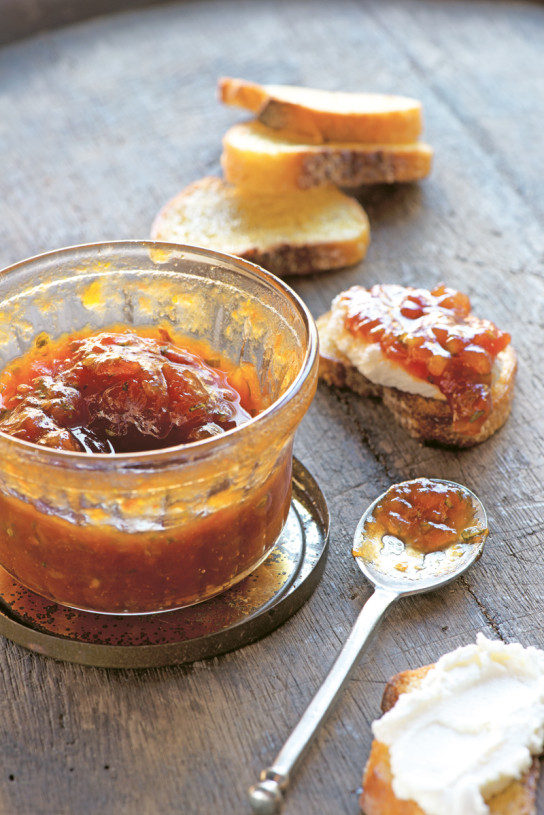Imagine sitting down at your table for a meal made with fruits and vegetables you grew yourself, along with eggs and honey from your own backyard chickens and bees. It’s one of life’s greatest, simplest pleasures — and for Jeanne Kelley, it’s an everyday reality.
Kelley is the author of The Kitchen Garden Cookbook, our pick for April’s Cookbook Club. An avid gardener and cook, Kelley grows produce and raises bees and chickens in her yard, while also raising chickens and honeybees. Her book is full of more than 100 easy-to-prepare recipes making the most of peak-season fruits and vegetables. Whether you’re a gardener or farmers’ market shopper, these colorful recipes are sure to inspire.
In the Q&A below, we asked Kelley for her best tips for gardeners, including those just getting started. Read on for her suggestions (and favorite recipes!) and scroll to the bottom of this post to learn more about our Cookbook Club.
Tell us about your background. How did your gardening experience prepare you to write The Kitchen Garden Cookbook?
I come from a family of cooks — my mother cooked for the family every night, and my dad loved to cook for parties. All of my brothers and my sister are excellent cooks. Good food was a part of my life, and I decided on a culinary career at a very young age. I spent an exchange year in the south of France at 16 and then catered a while in high school. I attended La Varenne cooking school in Paris and worked in restaurants. By the time I was 23, I was already contributing to food magazines. Gardening and keeping chickens and bees are an extension of good cooking and have proved to be both a way for me to expand my knowledge of food, deepen my understanding of ingredients and grow as a cook. Gardening has made me a better cook. My family eats a very healthy diet, because not only do we truly love vegetables we’re usually inundated by them!
How can people – whether new to gardening or not – use the book? What about people who don’t have space for a garden?
The Kitchen Garden could certainly be enjoyed as a gardening manual, but it’s filled with so many great-tasting and easy recipes that it would be a shame to overlook it as cookbook. While I do encourage people to start their own vegetable gardens, I certainly don’t grow everything I eat. The recipes in this book work equally well with farmers’ market and good-quality supermarket produce. Folks without gardens or the inclination to garden will find new and delicious ways of experimenting with a larger variety of vegetables and fruit by putting more fresh, healthy food on the table.
How did you decide which ingredients to spotlight? What would you recommend starting with?
The fruits, vegetables and herbs featured in the book are a roundup of “greatest hits” from the garden. The focus is on plants that are relatively simple to grow and are versatile in the kitchen. I was also looking for a good balance of spring, summer, fall and winter produce.
If you’re just getting started in the garden and want to focus your efforts, grow tomatoes. Homegrown tomatoes picked warm from the vine are so juicy and delicious. When you experience a backyard tomato, the quality is so exciting. Tomatoes are easy to grow, too, so they really boost gardening confidence.
 How would you characterize the recipes in the book?
How would you characterize the recipes in the book?
The recipes are very simple because they are designed to showcase fruits, vegetables, herbs, honey and eggs at their just-harvested peak. I’m not a fussy cook — and with lovely garden-fresh produce, elaborate preparation would be like gilding a lily. The recipes are also inspirational. I really want people to see that time spent growing and tending a garden yields better produce and less time in the kitchen. My hope too is that the book teaches cooks to make the most of seasonal produce and spreads my love of vegetables.
How do chickens and bees fit into the idea of a kitchen garden? Tells us about some of your favorite uses for eggs and honey.
Chickens and bees are part of a big, beautiful cycle. The bees pollinate the fruits and vegetables in the garden. My family enjoys eating what we grow. We feed our chickens garden scraps, and the chickens lay eggs for us to enjoy. Our compost is enriched with eggshells and chicken manure, which fertilizes the garden and brings us back to the bees. This whole process is sweetened with honey.
Fresh eggs are phenomenal. I’ve done taste tests with farmers’ market eggs and backyard eggs, and nothing beats the home-lain egg. Backyard eggs are such a treat that I enjoy them breakfast, lunch and dinner. Eggs on toast, egg salad sandwiches and frittatas — it’s all so good.
I use honey as a sweetener in many recipes. Homegrown fruit is super sweet and usually needs no embellishment, but a light drizzle of honey can really enhance and deepen flavors.
What are your favorite recipes from the book and why?
There are so many inspiring recipes in this book — my favorite basically changes from season to season. At this point, I’m really loving the Frozen Honey Cream. It’s so simple and fast to make, and it’s wonderful on its own or with spring strawberries.
I’m also dreaming about my Tomato Jam with Marjoram and Honey. The jam is super delicious and a great way to use up the garden’s less-than-perfect tomatoes. I love the jam with goat cheese or slathered on a grilled cheese and smoked turkey sandwich. It’s a great way to prolong the flavor of summer into fall.
Frozen Honey Cream
Whenever I serve this luscious dessert to friends, they are amazed that you don’t need an ice cream maker to achieve the creamy texture. Honey has a low freezing point, so even though this mousse is simply frozen in a tub, the texture is magical. Serve it on its own, with chocolate sauce, or with fruit.
1 cup (8 fl. oz./250 ml.) heavy cream, cold
1/4 cup (3 oz./90 g.) honey, plus more for drizzling (optional)
2 large egg whites
Pinch of kosher salt
1/4 cup (2 oz./60 ml.) sugar
Fresh lavender blossoms for garnish (optional)
In a bowl, using a handheld mixer, beat together the cream and honey on low speed until the honey dissolves. Increase the speed to high and whip until peaks form.
Rinse the beaters and dry well, then refit to the mixer. In a large bowl, using the mixer on high speed, beat together the egg whites and salt until foamy. Gradually add the sugar and whip until medium peaks form. Using a rubber spatula, fold the egg whites gently but thoroughly into the whipped cream mixture. Transfer the mousse to a 3-cup (24 fl. oz./750-ml.) container and freeze overnight.
Spoon the mousse into shallow serving dishes and drizzle with a small amount of additional honey, if desired. If you like, sprinkle each portion with lavender blossoms just before serving. Serves 6-8.
Tomato Jam with Honey & Marjoram
Each spring I plant both heirloom and hybrid tomatoes. The hybrids are an “insurance policy” in case a pest or disease knocks out the more sensitive heirlooms. This sweet-savory jam makes great use of my Better Boy and Early Girl hybrids. Try serving the jam atop baguette slices spread with Bucheron or another fresh goat cheese.
3 lb. (1.4 kg.) red tomatoes
1/3 cup (1 1/2 oz./45 g.) shallot, minced
1/8 tsp. red pepper flakes
1/4 cup (2 oz./60 g.) firmly packed golden brown sugar
1/4 cup (2 oz./60 g.) granulated sugar
2 Tbs. honey
1 Tbs. sherry vinegar
2 Tbs. chopped fresh marjoram
Bring a large saucepan three-fourths full of water to a boil. Meanwhile, using a small, sharp knife, cut out the stem from each tomato, then cut a small, shallow X on the blossom end. Working in small batches, immerse the tomatoes in the boiling water until the skins blister, about 30 seconds. As they are ready, using a slotted spoon, transfer the tomatoes to a colander.
Working over a bowl, peel the tomatoes, discarding the skins. Using your fingers, break the tomatoes open and gently squeeze and scrape the seeds and juices into the bowl. Transfer the flesh to a small, heavy saucepan. Strain the juices through a fine-mesh sieve into the pan, discarding the seeds.
Add the shallot and red pepper flakes to the tomatoes, place the pan over medium heat, bring to a simmer, and simmer until the mixture is reduced to 2 cups (12 oz./375 g.), about 12 minutes. Add both sugars, the honey, and the vinegar and continue to simmer, stirring often, until the mixture is thickened to a jam consistency, about 7 minutes.
Remove from the heat and stir in the marjoram. Transfer the jam to clean jars, let cool, cap tightly, and refrigerate. It will keep for up to 2 weeks. Makes about 2 half-pint (8-fl. oz./250-ml. each) jars.
Love collecting cookbooks? Enjoy trying new recipes? Join us for a monthly Cookbook Club class. Led by our talented culinary experts, these exclusive cooking classes showcase recipes from a different cookbook each month.
- Each 1½ – to 2-hour class features cooking tips and techniques and a three-course tasting menu from the book’s best recipes, prepared while you watch.
- Class fee of $75 includes the cookbook with signed bookplate.
- Participants receive a 10% discount on store purchases the day of the class.
- Available monthly at select stores; class times vary by store location.
- Space is limited and reservations are required. Call a participating store to register.



1 comment
I’m currently reading this too! Love it! 😉